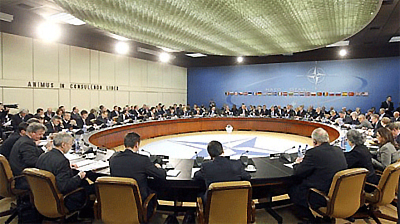NATO to Shun Major Eastern Footprint in Nod to Russia

(Bloomberg – bloomberg.com – James G. Neuger, Patrick Donahue – August 18, 2014) NATO will stop short of basing substantial combat forces in eastern Europe to avoid a complete rupture in relations with Russia, German Chancellor Angela Merkel said.
A North Atlantic Treaty Organization summit next month will settle on other ways of protecting the alliance’s eastern flank, including previously floated plans for more war-games, a more robust command structure and warehousing equipment that would be needed in an emergency, Merkel and allied officials said.
Defensive steps triggered by Russia’s pressure on non-NATO member Ukraine “don’t involve a permanent, sustained stationing of fighting troops, but we can strengthen our cooperation very much in other ways,” Merkel told reporters today in Latvia, one of the frontline states pleading for more vigilance against the Kremlin.
NATO’s new defense posture, to be unveiled at a Sept. 4-5 summit in the U.K., was always bound to be the product of compromise: all 28 allies have to agree and many, in both western and eastern Europe, want to continue to do business with Russian President Vladimir Putin.
“This is certainly a disappointment for the eastern members of NATO,” said Joerg Forbrig, Berlin-based senior program officer at the German Marshall Fund of the U.S. “Ruling out anything at this stage — any steps or measures we might need to take — is simply a mistake given events in Ukraine over the past year.”
1997 Agreement
NATO will abide by a commitment made in 1997 — when a post-Cold War partnership with Russia beckoned — to refrain from the “permanent stationing of substantial combat forces” in eastern Europe, a senior NATO diplomat told reporters in Brussels today.
“Substantial” has generally been defined as a “brigade formation,” the diplomat said. In April, the U.S. stayed below those limits when it sent 600 paratroopers from the 173rd Airborne Brigade on training rotations in eastern Europe, spreading them between four countries: Estonia, Latvia, Lithuania and Poland.
While those four have spearheaded calls for a reinforced NATO, on guard against Russian aggression, that sentiment is not held as fervently across the alliance, even in eastern European capitals once under the Kremlin’s yoke. The leaders of Hungary and Slovakia, for example, have expressed doubt about European sanctions on Russia.
Alliance Exercises
NATO will continue to hold more exercises to keep its forces ready, some among the allies, some with affiliated countries. Two maneuvers are scheduled with Ukraine in September: a 15-nation field training exercise and an annual Black Sea naval exercise.
As a NATO partner rather than member, Ukraine isn’t entitled to the same collective defense guarantee that has animated the alliance since it was set up as a bulwark against the Soviet Union in 1949. Ukraine’s new government has said membership isn’t a priority, and Putin is determined to keep Ukraine out of NATO’s orbit.
The alliance plans to retool a rapid-reaction force, set up in 2002, that has never gone into combat. It currently needs anywhere from one to six months to take the field, and isn’t geared to the “hybrid,” infiltration-style warfare practiced by Russia against Ukraine, the diplomat said.
At the summit, allied leaders will also wrestle with the decline in defense budgets that has left only four countries — the U.S., U.K., Estonia and debt-ravaged Greece — meeting an informal goal of spending at least 2 percent of gross domestic product on the military.
Another seven have pledged to get up to that level in the wake of Russia’s intimidation of Ukraine. Whether the summit will set a precise target with binding deadlines is uncertain, partly because debate rages over what the money is spent on, the diplomat said.
Article ©2014 Bloomberg L.P. All Rights Reserved. Article also appeared at bloomberg.com/news/2014-08-18/nato-to-shun-major-eastern-footprint-in-nod-to-russia.html
